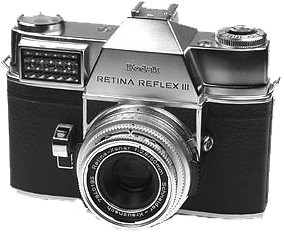
Approx. dates of manufacture: 1961 to 1964
Lens Mount: DKL bayonet
Approx. original price: $124.50
Approx. street value: Moderate
Eastman Kodak was one of the USA's earliest corporate giants, and a lot of the things one sees in later companies like Ford, General Motors and Microsoft could be seen early on in Kodak's own history. They all emerged from a cottage industry. They were all admired, loved and despised, depending on where you stood. They fought, bought and destroyed their competitors ruthlessly.
Like Ford, Kodak's bread and butter was its mass-market sales of cheap cameras, typically Brownies, but like General Motors, they were very interested in dominating the broad market. At its height around World War II, Kodak had its hand in virtually every area of photography, from the lowest cheap Brownies and Verichrome film, to the commercial high-end with the Masterview view camera, Medalist medium format, Commercial Ektar optics, quality films, filters, darkroom chemicals and paraphanalia galore. For awhile if you wanted something photographic, Kodak made a product that filled the niche.
s.jpg) One of Kodak's subsidiaries was a German camera maker, and from them they got their high-end 35mm cameras which they named
the Retina series. There were folding Retinas and fixed-lens Retinas
and a series of Retinettes; and at the end of its run in the early 1960's, Kodak even had a 35mm
SLR, the Retina Reflex series.
One of Kodak's subsidiaries was a German camera maker, and from them they got their high-end 35mm cameras which they named
the Retina series. There were folding Retinas and fixed-lens Retinas
and a series of Retinettes; and at the end of its run in the early 1960's, Kodak even had a 35mm
SLR, the Retina Reflex series.
I've never owned a Retina because they were always expensive, even decades after they were made. But when this Retina Reflex showed up at a thrift shop for a reasonable price ($50), I grabbed it.
This particular one has a Schneider Xenar ƒ/2.8 lens (there was more expensive Schneider Xenon ƒ/1.9 variant), is dense and shiny and very German (it bears a far stronger resemblance to my Voigtländer Vito rangefinders than any of the Japanese SLRs of the era).
I haven't had much time to go over it, but what I've seen is something else. There are interchangable lenses for it (I shudder to think how much they are), the meter still seems to work (thank God for old photocells. It's not great, but they don't need batteries). The focus is bright and crisp. There's a nifty f-stop/shutter speed interlock, and best of all, I could figure out almost all of it without having to read the manual.
For more information: Wikipedia: Retina Reflex III
For more information: Last Best Photography
Modern Photography magazine camera test: September 1961
Camera manual: Orphan Cameras.com


